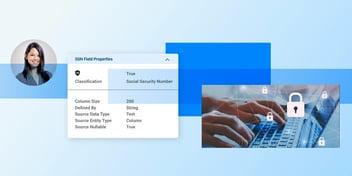Hiding in plain sight: Data obfuscation disguises sensitive data by hiding its true meaning to protect it from unauthorized access, breaches, or misuse.
What data obfuscation is
Obfuscation is the act of making something obscure or unintelligible. When it comes to data, this refers to disguising confidential or sensitive data to protect it from unauthorized access.
Essentially, data obfuscation is a form of data masking that works by replacing Personally Identifiable Information (PII) with realistic, but fake, data. Although the data seems like it comes straight from production, it’s basically useless to unauthorized individuals. Obfuscation is especially useful in test or development environments, where realistic data is required to build and test software without the need for real-world data.
Get Gartner’s market guide to data masking absolutely FREE.
Through data obfuscation, developers can modify sensitive data while maintaining the integrity of the underlying structure. This enables them to generate realistic test scenarios without exposing actual user information or breaching privacy regulations. For example, a developer could use data obfuscation to run tests on how a new application will perform. By maintaining the schema and any anomalies in the data, developers can realistically see how the app would handle these anomalies, without compromising user privacy.
Why data obfuscation is so important
Data obfuscation helps mitigate the constant tension organizations face when it comes to data privacy and data usability. By replacing real data with fake data, user privacy is protected without affecting critical business processes. Data obfuscation is particularly useful to organizations that wish to:
-
Work with third parties
Transmitting PII, payment card details, or health information to third parties poses many risks. It increases the number of individuals with access to the data, reduces the organization's control over the data, and exposes the company to potential regulatory violations. Data obfuscation minimizes these risks by ensuring that sensitive information is not exposed during interactions with external entities. -
Reduce unnecessary exposure of real data
Many business operations, such as development, testing, analytics, and reporting, don’t need actual personal data. Using real data needlessly exposes it to employees, contractors, and other parties. Data obfuscation provides organizations with an alternative that allows them to maintain their business processes, while eliminating the risk associated with handling real personal data. -
Stay compliant with regulations
Compliance with data protection regulations is a constant concern for organizations. For instance, the European Union's General Data Protection Regulation (GDPR) mandates the application of data masking tools to sensitive data collected on EU citizens. Data obfuscation techniques align with these regulations and help organizations fulfill their compliance obligations.
Data obfuscation techniques
Data obfuscation can be achieved through different methods. These techniques can be used individually or in combination, depending on the specific requirements and objectives of the data obfuscation process. There are 3 primary data obfuscation techniques:
-
Masking out
Masking out is one of the most effective data masking techniques because it creates different versions of data, while maintaining a similar structure in each version. In this process, the data type remains unchanged, but the values are modified. Various modifications can be applied, such as shifting numbers or letters, replacing words, or switching partial data between records. This allows authorized users to work with realistic data without exposing sensitive information. -
Data encryption
In an anonymization vs encryption comparison, data encryption uses cryptographic methods, typically symmetric or private/public key systems, to encode the data – rendering it completely useless until decrypted. Although encryption provides a high level of security, it restricts a user’s ability to manipulate or analyze the data while it’s encrypted. Data encryption is especially effective when secure storage or transmission of sensitive data is required. -
Data tokenization
Data tokenization tools replace specific data with meaningless values, known as tokens. Authorized users can link the tokens to the original data, allowing them to perform operations without exposing sensitive information. For example, tokenized data can be used in production environments to execute financial transactions without transmitting credit card numbers to external processors. This technique ensures data privacy while enabling essential business processes.
Along with these techniques, data perturbation and data subsetting are also commonly used.
Data perturbation involves introducing controlled changes to the data while preserving its statistical properties. The purpose is to create a modified dataset that is still representative but does not disclose sensitive information.
Perturbation adds noise, shuffles values, or alters numerical values within certain limits. For example, instead of simply replacing employee names with fake names, shuffling takes a more complex approach by scrambling the real names within a dataset, ensuring that the rearrangement spans multiple records.
Data subsetting, on the other hand, involves selecting and extracting a subset of the original data for specific purposes, while excluding sensitive or irrelevant information. By working with smaller subsets, organizations can limit the exposure of sensitive data during development, testing, or analysis processes.
Entity-based data obfuscation
Entity-based data masking technology allows for better data obfuscation. It enables a wide range of techniques, scales up or down as needed, enforces referential integrity, hastens compliance, and integrates into your existing systems quickly and easily.
Unlike other alternatives, entity-based data obfuscation delivers all the data corresponding to a single business entity (a customer, device, or order, etc.) to authorized data consumers, while obfuscating data inflight.
By adopting an entity-based approach, companies optimize their test data management tools, speed up software delivery, and make their data governance more effective. It protects data in transit and at rest, for stronger data functionality and security.
Discover K2view data masking tools, the only data obfuscation solution you'll ever need















